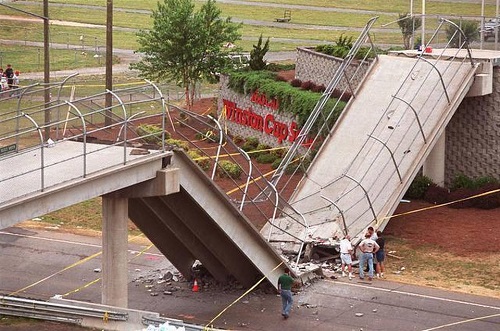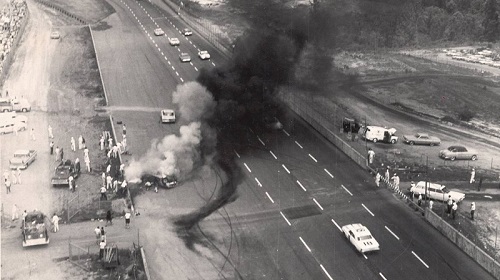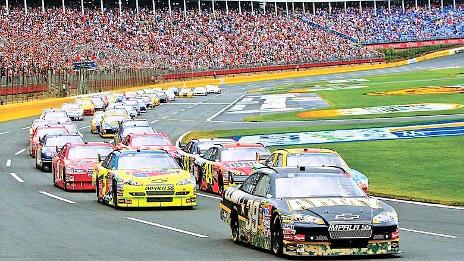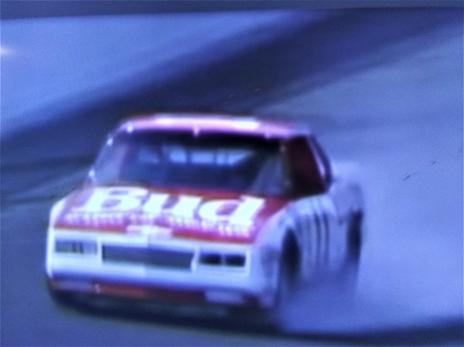CHARLOTTE MOTOR SPEEDWAY - CONCORD NC

Charlotte Motor Speedway was designed and built by Bruton Smith and partner and driver Curtis Turner in 1959. The first World 600 NASCAR race was held at the 1.5 mi speedway in June 1960. In December 1961, the track filed for bankruptcy and it was reorganized under Chapter 10 of the Bankruptcy Act. By April 1963 some $750,000 had been paid to creditors and the track emerged from bankruptcy. Smith had departed from the track in 1962 to pursue other interest; mostly in banking and auto dealerships. He began buying up shares of the speedway and in 1975 he became the majority stockholder and regained control of it's day to day operations. He hired H.A. "Humpy" Wheeler as Genral Manager. Together Smith and Wheeler began to implement plans for improvement and expansion of the speedway. In the following years, new grandstands and
luxury suites were added along with modernized concessions and restrooms to increase the comfort for race fans. The speedway became the first sports facility in America to offer year round living accommodations when 40 condominia were built overlooking turn 1 in 1984, twelve additional condominium units were later added in 1991. In 1992, Smith and Wheeler directed the installation of a $1.7 million, 1,200-fixture permanent lighting system around the track developed by Musco lighting. The track became the first modern superspeedway to host night racing. Track president "Humpy" Wheeler retired following the Coca-Cola 600 on May 25, 2008, and was replaced by Marcus Smith. In September 2010, the speedway announced a partnership with Panasonic to install the world's largest high definition


video board at the track. The video board measures approximately 200 feet wide by 80 feet tall, containing over nine million LED lights. On May 20, 2000, fans were crossing a pedestrian bridge from the track to a nearby parking lot after a NASCAR all-star race. An 80-foot section of the walkway fell onto a highway in Concord. In total, 107 fans were injured at Lowe's Motor Speedway when the bridge dropped 17 feet to the ground. Investigators have said the bridge builder, Tindall Corp., used an improper additive to help the concrete filler at the bridge's center cure faster. The additive contained calcium chloride, which corroded the structure's steel cables and led to the collapse. The incident is considered
one of the biggest disasters in NASCAR history. As far as racing action. The first race was held in 1960 and was a 600 mile marathon. That distance has remained a constant ever since that race with races in May being 600 miles; the only 600 miles ever ran in NASCAR. The track had to be rushed to be completed for the first race and was in rough shape. The first race saw 60 cars start and before the race was over the track was starting to come apart with the ashpalt coming up in several places. Many cars fell out because of holes being knocked in the gas tanks and other mechanical issues caused by the rough surface. When the checkered flag flew and cars went to post-race tech; we saw six cars disqualified. Among


them Lee and Richard Petty, Bob Welborn and Junior Johnson. When the dust settled 17 cars finished the race, and Joe Lee Johnson had gotten the win after leading the last 48 laps. One of the saddest days at the track came in May 1964. Fireball Roberts had qualified in the eleventh position and started in the middle of the pack. On lap seven, Ned Jarrett and Junior Johnson collided and spun out and Roberts crashed trying to avoid them. Roberts' Ford slammed backward into the inside retaining wall, flipped over, and burst into flames. Witnesses at the track claimed they heard Roberts screaming, "Ned, help me", from inside his burning car after the wreck. Jarrett rushed to save Roberts as his car was engulfed by the flames. Roberts suffered second-and third-degree burns over eighty percent of his body and was airlifted to a hospital in critical condition. Roberts was able to survive for several weeks, and it appeared he might pull through,
but he took a turn for the worse on June 30, 1964. He contracted pneumonia and sepsis and had slipped into a coma by the next day. Roberts died from his burns on July 2, 1964. The mid-to late '70 provided some of the most competitive racing. In the World 600 in 1974; although there were only five different leaders, the race saw 37 lead changes. David Pearson managed to wrest the lead away from Richard Petty with nine laps to go to get the win. The Fall race in 1974 saw 47 lead changes although it was only a 500 mile race. Eleven different drivers held the point, but once again Pearson would get the win. As of 2022; the race with the most lead changes came in 1979. Ten drivers would spend some time up front as on many occasions the lead would change every few laps. On 38 occasions a driver held the lead for five laps or less. But with 92 laps to go, Darrell Waltrip's crew got the handle on his car figured out and he led the final 92 circuits. Still, it was a hard-fought battle as he was only able to beat Richard Petty by five seconds. To date Jimmie Johnson has the most Cup wins at the track (8); followed by Bobby Allison and Waltrip with six each. Charlotte also hosts the NASCAR All Star race. The first race was held in 1985 and Darrell Waltrip won as his motor blew as he took the checkered flag. 1986 saw the All Star race held at Atlanta, before it returned to Charlotte where it remained until 2020.
All Photos copyright and are property of their respective owners
